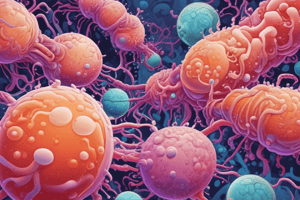Podcast
Questions and Answers
Which of the following bacteria is a major cause of meningitis and septicemia?
Which of the following bacteria is a major cause of meningitis and septicemia?
- Moraxella
- M.catarrhalis
- N.gonorrhoeae
- N.meningitidis (correct)
What is a common mechanism of antibiotic resistance in Neisseria and Moraxella?
What is a common mechanism of antibiotic resistance in Neisseria and Moraxella?
- Beta-lactamase production
- Alteration of penicillin-binding proteins
- Both A and B (correct)
- None of the above
How do Neisseria and Moraxella adhere to host cells?
How do Neisseria and Moraxella adhere to host cells?
- Via pili and outer membrane proteins (correct)
- Via flagella
- Via antigenic variation
- Via type III secretion system
What is a key mechanism by which Neisseria evades the host immune response?
What is a key mechanism by which Neisseria evades the host immune response?
What is the primary route of colonization for N.meningitidis?
What is the primary route of colonization for N.meningitidis?
What is a characteristic of the type IV pili-mediated invasion of host cells by Neisseria?
What is a characteristic of the type IV pili-mediated invasion of host cells by Neisseria?
Flashcards are hidden until you start studying
Study Notes
Classification
- Neisseria and Moraxella are both Gram-negative, aerobic bacteria
- Belong to the family Neisseriaceae
- Neisseria genus includes:
- N. meningitidis (causes meningitis and septicemia)
- N. gonorrhoeae (causes gonorrhea)
- Moraxella genus includes:
- M. catarrhalis (causes respiratory tract infections)
Antibiotic Resistance
- Neisseria:
- Increasing resistance to penicillin, tetracycline, and sulfonamides
- Resistance mediated by beta-lactamase production and alteration of penicillin-binding proteins
- Moraxella:
- High levels of resistance to ampicillin, amoxicillin, and trimethoprim-sulfamethoxazole
- Resistance due to beta-lactamase production and alterations in penicillin-binding proteins
Host-Pathogen Interaction
- Neisseria:
- Adhesion to host cells via pili and outer membrane proteins
- Invasion of host cells through type IV pili and type III secretion system
- Evasion of host immune response through antigenic variation and immune suppression
- Moraxella:
- Adhesion to host cells via pili and outer membrane proteins
- Induction of pro-inflammatory response and oxidative stress in host cells
Pathogenesis
- Neisseria:
- N. meningitidis: causes meningitis and septicemia through colonization of nasopharynx, invasion of bloodstream, and dissemination to meninges
- N. gonorrhoeae: causes gonorrhea through colonization of urogenital tract, induction of inflammation, and damage to epithelial cells
- Moraxella:
- M. catarrhalis: causes respiratory tract infections, including otitis media, sinusitis, and bronchitis, through colonization of respiratory tract and induction of inflammation
Diagnostic Techniques
- Neisseria:
- Culture on selective media (e.g. Thayer-Martin agar)
- PCR and DNA-DNA hybridization for species identification
- Serotyping for meningococcal disease
- Moraxella:
- Culture on non-selective media (e.g. blood agar)
- Biochemical tests (e.g. catalase, oxidase) for species identification
- PCR and DNA-DNA hybridization for species identification
Studying That Suits You
Use AI to generate personalized quizzes and flashcards to suit your learning preferences.




